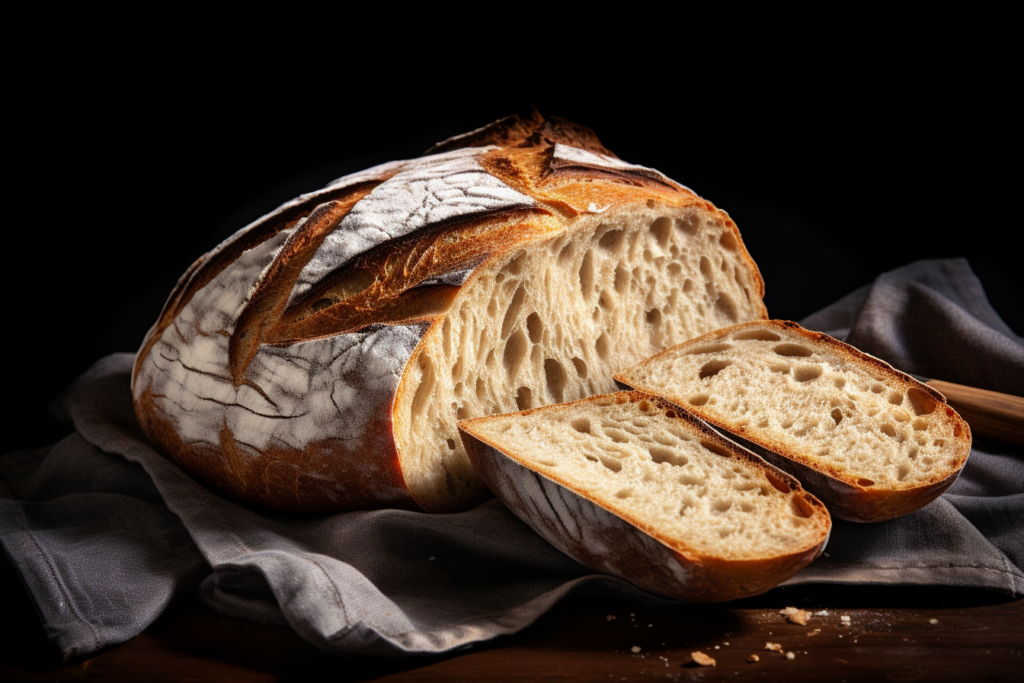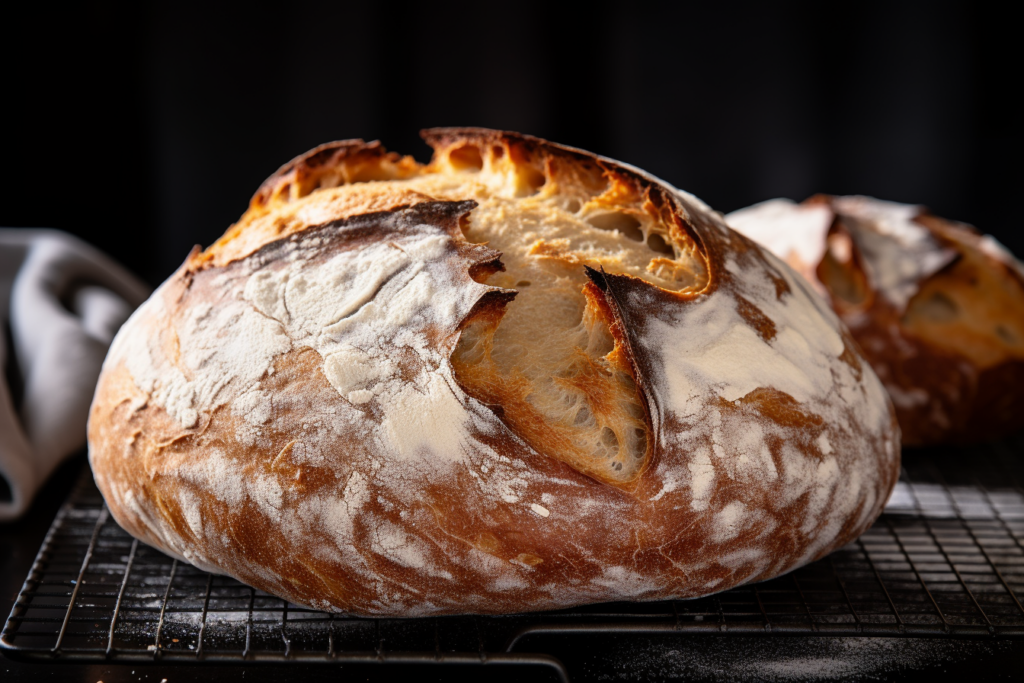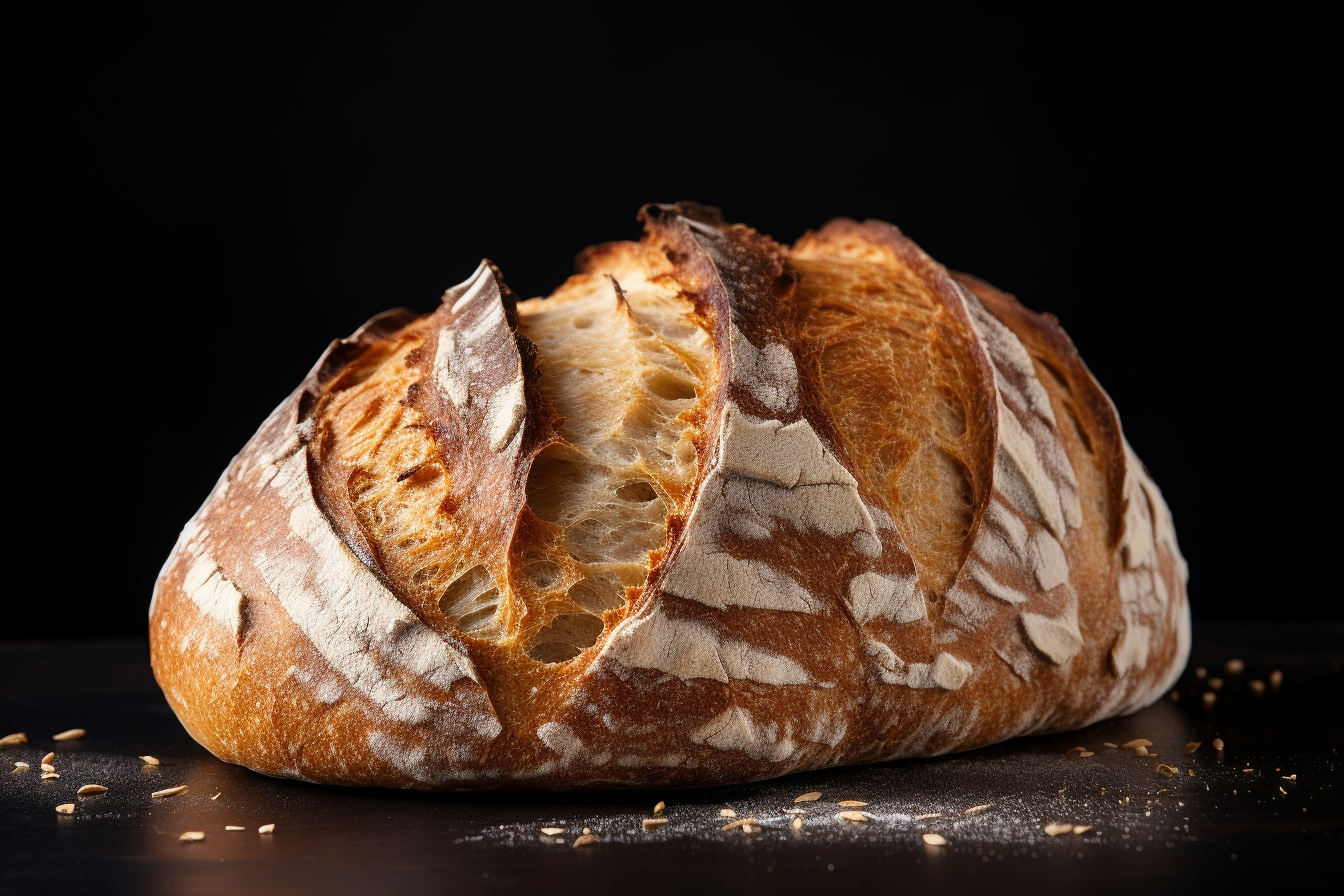Welcome to the delicious world of sourdough bread, where simple ingredients can be magically transformed into a mouthwatering masterpiece. All you need for this fascinating trip into the heart of sourdough bread creation is flour, water, and a dash of patience.
Let’s keep things easy. Forget the complex components; all you need is flour, water, and a small amount of salt. The wild yeast, which is responsible for the unique tang and chewiness, is the true star of this recipe. It’s similar to baking with a hint of allure from nature.
Are you feeling overwhelmed? Don’t be. This isn’t just a recipe; it’s an adventure. Every small step is a pleasant accomplishment, whether you’re raising your own sourdough starter or just giving your dough some tender love and care. Imagine being able to remove a rustic, crusty loaf from your oven with just a little patience and skill.
So, get ready for a simple yet magical journey into the world of sourdough. Flour on your hands, a bit of water, and a sprinkle of salt – let’s turn these basic ingredients into bread and serve it with Grilled Skirt Steak to get compliments. That not only fills your stomach but also warms your soul. It’s not just baking; it’s creating a delicious legacy in your kitchen. Ready, set, bake!
What is Sourdough?
A unique type of bread known as sourdough is produced by a spontaneous fermentation process. It is unique in that it uses a sourdough starter—a concoction of flour and water—to draw in bacteria and wild yeast from the surrounding environment. This starting is then added to the bread dough, replacing the typical commercial yeast.
Sourdough gets its distinctively acidic flavor and chewy texture from fermentation. People adore sourdough because of its distinct flavor, enhanced digestion, and possible health advantages. It’s a favorite among people who like basic yet flavorful artisanal bread prepared by hand.
What is a Sourdough Starter?
A sourdough starter is a mix of flour and water that captures wild yeast and bacteria from the air. To make one, you combine flour and water and let it sit for a few days. During this time, wild yeast and bacteria join in, making the mixture bubbly and ready to leaven bread.
Once established, you regularly “feed” the starter by removing some and adding fresh flour and water. This keeps the natural yeast and bacteria active. The starter is then used to make sourdough bread, providing the natural fermentation that gives it its special taste and texture. Sourdough starters can be kept for a long time, creating a continuous cycle for baking tasty homemade bread.
Overview: How to make Sourdough Bread?

Baking bread with sourdough at home is an easy and satisfying recipe just like Buttermilk Cornbread. To start, make a sourdough starter by combining flour and water, then let it to gradually absorb wild yeast over several days. The starter is ready to use after consistent feeding, adding a unique tangy flavor and chewy texture to your bread.
To make the dough for the bread, combine the starter with flour, water, and a small pinch of salt. Before baking, let it rise, form it, and let it rise one more. What was the outcome? A distinct flavor of handcrafted sourdough loaf, crisp and crunchy. Although it requires some patience and time, the homemade sweetness is well worth the effort.
So, roll up your sleeves, savor the smell of freshly baked bread, and enjoy the process of crafting your own sourdough masterpiece.
Choosing the Right Flour for Your Sourdough
- All-purpose Flour: Versatile choice for balanced flavor.
- Bread Flour: Higher protein, great for a chewier texture.
- Whole Wheat Flour (Optional): Adds nuttiness, consider hydration adjustments.
- Experimentation: Start basic, and gradually explore diverse flours.
Choosing the right flour depends on your taste preferences and desired texture. Beginners often find success with all-purpose flour before exploring other options.
Homemade Sourdough Bread Recipe
Equipment
- Mixing Bowls
- Measuring Utensils
- Jar or Container
- Dutch Oven
- Proofing Basket
- Sharp Knife
- Kitchen Towels
- Silicone or Plastic Scraper
- Cooling Rack
Ingredients
Sourdough Starter
- 1 cup all-purpose flour
- ½ cup lukewarm water
Sourdough Bread
- 1 cup sourdough starter
- 1 ½ cups lukewarm water
- 4 cups bread flour
- 1 ½ teaspoons salt
Instructions
Sourdough Starter
- In a clean jar or container, mix the flour and water until you have a thick but smooth consistency.
- Cover the jar loosely with a cloth or plastic wrap, allowing airflow.
- Leave the jar at room temperature (around 70°F or 21°C) for 24 hours.
- After 24 hours, discard half of the starter and add another 1/2 cup of flour and 1/4 cup of water. Stir well.
- Repeat this feeding process every 24 hours for 5-7 days, or until the starter is bubbly and has a pleasant sour aroma.
Sourdough Bread
- In a large mixing bowl, combine the sourdough starter, lukewarm water, and 3 cups of bread flour. Mix until a shaggy dough forms.
- Add the salt and gradually incorporate the remaining flour until a sticky dough forms.
- Knead the dough on a floured surface for about 10 minutes or until it becomes smooth and elastic.
- Place the dough in a lightly oiled bowl, cover with a cloth, and let it rise at room temperature for 4-6 hours, or until it doubles in size.
- Preheat your oven to 450°F (230°C). If you have a Dutch oven, preheat it as well.
- Shape the dough into a round loaf and place it in a floured banneton or on parchment paper.
- Let the dough rise for another 30-60 minutes.
- Score the top of the dough with a sharp knife or lame.
- If using a Dutch oven, transfer the dough into the preheated pot. Otherwise, place the parchment paper with the dough on a baking stone or tray.
- Bake for 25-30 minutes with the lid on (if using a Dutch oven), then remove the lid and bake for an additional 10-15 minutes or until the crust is golden brown.
- Allow the bread to cool on a wire rack before slicing.
Notes
Nutrition
NUTRITIONAL FACTS (PER SERVING)
| Nutrient | Amount per Serving |
|---|---|
| Calories | 110 |
| Total Fat | 0.5g |
| Saturated Fat | 0g |
| Trans Fat | 0g |
| Cholesterol | 0mg |
| Sodium | 220mg |
| Total Carbohydrates | 22g |
| Dietary Fiber | 1g |
| Sugars | 0g |
| Protein | 3g |
Sourdough Health Benefits

Sourdough bread offers several potential health benefits:
- Digestibility: The fermentation process breaks down gluten and phytic acid, potentially making sourdough more digestible for individuals with mild gluten sensitivity or digestive issues.
- Nutrient Absorption: Fermentation may enhance the bioavailability of certain nutrients, making them easier for the body to absorb.
- Blood Sugar Control: Sourdough has a lower glycemic index compared to some other bread types, potentially providing better blood sugar control.
- Probiotics: The presence of natural fermentation introduces beneficial bacteria (probiotics) to the gut, supporting a healthy digestive system.
- Minimized Additives: Homemade sourdough often contains fewer additives and preservatives compared to commercially processed bread, promoting a cleaner ingredient profile.
It’s important to note that individual responses to sourdough can vary, and these potential benefits may not be universal. Additionally, moderation and overall dietary context play crucial roles in reaping these benefits.
What to pair with Sourdough Bread?
Storage and Leftover Tips!
Storage:
- Room Temperature: Keep at room temp for 2-3 days.
- Refrigeration: Store in the fridge for a longer shelf life.
- Freezing: Slice and freeze for extended storage.
Leftovers:
- Revive Staleness: Spritz with water and reheat in the oven.
- Croutons or Bread Crumbs: Perfect for salads or toppings.
- French Toast or Bread Pudding: Ideal for decadent treats.
- Soup Thickener: Add to thicken soups and stews.
- Make Chips: Slice and bake for crunchy snacks.
Frequently Asked Questions (FAQs)
Q1: How long does sourdough bread last?
A: Sourdough bread lasts 2-3 days at room temperature, 1-2 weeks in the fridge, and up to 3 months in the freezer when properly stored.
Q2: What does sourdough bread taste like?
A: Sourdough bread has a distinctive tangy flavor with a crisp crust and chewy interior, accompanied by subtle sweetness and nuttiness, creating a unique and delicious taste.
Q3: How many carbs and calories in sourdough bread?
A: Sourdough bread typically contains around 50-60 grams of carbohydrates and 250-300 calories per 100 grams, but actual values can vary based on ingredients and recipes.
Q4: What to make with sourdough bread?
A: Sourdough bread is versatile—enjoy it toasted with toppings, as a base for sandwiches, or transform it into delightful treats like French toast, croutons, and more!


Daniel
Tuesday 20th of February 2024
Please follow up with a recipe for diners who cannot tolerate gluten. Celiac and other diseases.